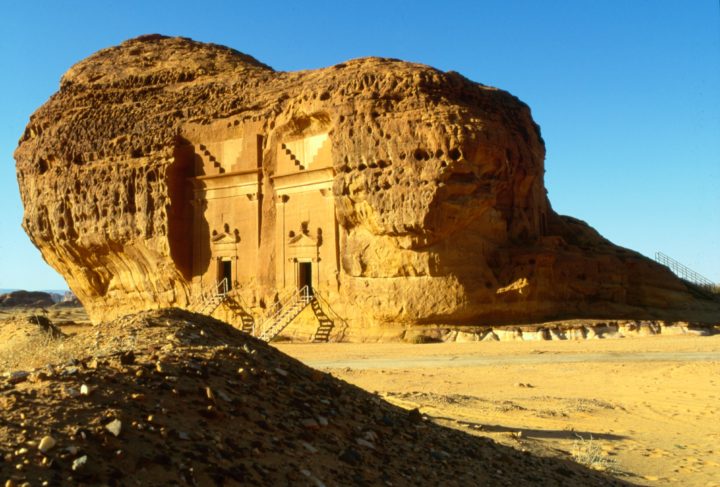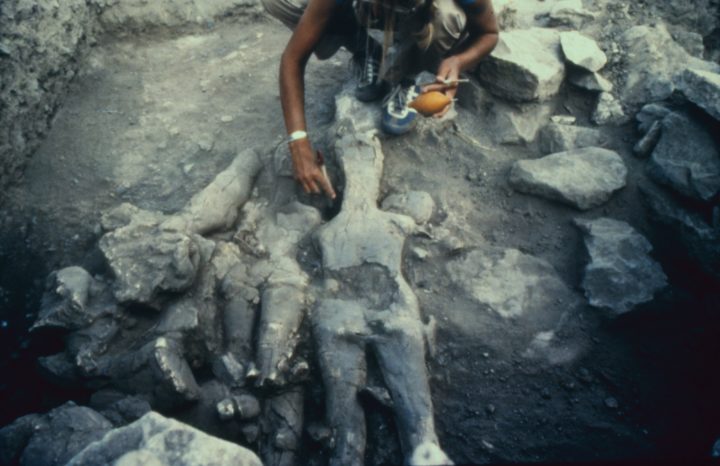By Jessica Holland, Archival Projects Consultant
“To reproduce an object is a task that requires know-how, but to understand what the object represents, its function or how it came to be, requires another kind of knowledge.”
—Akram Zaatari, Against Photography (Barcelona: Museu d’Art Contemporani de Barcelona, 2018, p. 103)
Achievements: reflections on four transformative years
Initiated in 2016 and encompassing the indexing, digitization, description, and online publication of 31,000 photographs, the ACOR Research Library Photographic Archive Project represented a great leap forward in ACOR’s efforts to enhance our archives, reduce barriers to information, and promote international scholarship. Thanks to a Title VI program American Overseas Research Centers (AORC) grant from the U.S. Department of Education (2016–2020), ACOR has been able to make thousands of photos downloadable instantly from its open-access online platform. These images, along with their metadata, can be reused anywhere.
Prior to this project, ACOR’s archival photographs lingered in the basement—undisturbed and uncataloged—for years, in formats that, in terms of modern library usage, were rapidly becoming inaccessible. Since the launch of the photo archive platform in 2017, these images have been in constant use by high-school and university students, professors, researchers, publishers, and prestigious institutions, such as the Smithsonian. In 2020, the photo archive processed its largest ever image request, providing an extraordinary 700 images to the Living Museum of Umm Qais project. ACOR’s archival materials have gone from being under threat of disintegration and all but out of reach to being digitally preserved and regularly accessed by over 6,500 distinct users each year.
One of the most significant achievements of this project was the creation of an authority list that for the first time compiles all major transliterations and Arabic-script versions of more than two hundred prominent heritage site names in Jordan. This list, made open access for other projects to benefit from, incorporates internationally recognized standards—including the Dublin Core Metadata Initiative, Library of Congress naming authorities, and local taxonomies (such as those of the Jordanian Department of Antiquities and Royal Geographic Society)—and thus provides previously disconnected data in one place.
In order to encourage scholarship based on ACOR’s archival materials, an exhibition and fifteen photo essays were published on the project website to provide context about the collections, greatly exceeding the project goal of only ten essays. Some are interviews with distinguished archaeologists, among them Nancy Lapp and Bert de Vries. Others draw out themes from among the images, such as the feminist history of archaeology and community heritage. People beyond ACOR are following suit with their own such works. In 2019, Boston College’s undergraduate journal of Middle Eastern studies, Al Noor, published a photo essay of Jane Taylor photographs from Mada’in Al-Saleh in Saudi Arabia.
Presentations designed to increase awareness of the photo archive have been given in the U.S. six times (including twice virtually), in Jordan eleven times, and twice in other international venues (London, Athens). Four video lectures, including one in Arabic, have been produced and shared widely online. These can be viewed on the ACOR YouTube channel. Once again, the project’s efforts far exceeded its stated goals, which were to give two U.S. and two international presentations. We are proud to have reached a much broader audience.
Building an interconnected community of practice
The ACOR Photo Archive was made possible through self-reflective collaboration. Although originally envisioned to solely make ACOR’s archival images available to academics and professionals, the project ended up interacting with a far broader audience. This was due to the variety of people who worked on the archive taking time to listen to what was important about the archive with respect to each other’s area of specialist knowledge and membership of different (potential user) communities. By listening to these insights, we were able to make decisions about the design of the online archive that would make it accessible to a range of international groups of differing education levels—from scholars to schoolchildren. Project archivists with master’s degrees in library and information studies (MLIS) and in digital humanities, museum studies, and the history of photography hailing from the U.S. and the UK worked together with Jordanian-Palestinian librarians and digitization technicians with in-depth archaeological knowledge of Jordan and the wider Middle East to produce an archive that was suited to the Jordanian context.
The ACOR library and archival team sought to share the archival knowledge they themselves were gaining through the project at every stage. A newly initiated program of digitization internships brought students and graduates from around the region to participate. In Jordan, ACOR is one of the few institutions offering such training, which directly helps to advance the field in the country. Since 2017, ACOR has run workshops on archival methods that have been instrumental in building an archival community of practice in Jordan and the wider region. Attendance trebled in three years, with sixty-five gallery, library, archive, and museum professionals from eighteen institutions participating in 2019. As a result of these initiatives, ACOR has become a hub for capacity-building in archival skills.
The photo archive team also sought to share lessons learned throughout the project by participating alongside peers and leaders in the field at the Council on Library and Information Resource’s Digital Library Forum 2019, as well as by bringing North American and international experts to Jordan.
All of these collaborations matter because decisions taken at the metadata level inform how digital objects are presented to—and therefore are understood by—both local and international communities. In the postcolonial context of overseas research centers such as ACOR, this is a significant responsibility. Consequently, the photo archive that this multicultural team produced is “fit for purpose” for promoting understanding of Jordan and the region locally and far beyond.
Arabic-language accessibility
In the course of the project, the team became increasingly aware of the limitations of the original project scope with regards to the language that would make it possible to sift through the 31,000-photo archive to locate images of a particular place or topic. As in the world of print publication, the digital humanities landscape has been dominated by the English language. As a result, English-language scholarship often provides the default references.
Translating the analog photographs to a digital existence on the open internet wasn’t enough to ensure sufficient access to the wide range of stories they had to tell. We needed to seize this opportunity of funded, focused efforts to literally translate the textual data they offer: the handwritten English-language notes of photographers and scholars that we were transcribing had to be translated into Arabic. We then needed to synthesize these notes in both languages into the mechanism for finding information online: search terms or keywords.
Through efforts pioneered by ACOR library staff, this two-step translation process, which provides rich information in Arabic as well as English, was given its initial trial run through the Madaba photo series within the Rami Khouri collection. This had great results but took double the time to produce the metadata, even though the academic texts consulted for the captions were available in Arabic, a rarity for cultural heritage texts.
The types of limitations we were encountering aren’t unique: digital humanities is an emerging field facing up to its inherited problems worldwide. However, as ACOR is a research center dedicated to supporting knowledge development within the postcolonial context of Jordan, it was vital for our team to deconstruct barriers blocking equitable access to archival material upon which further knowledge may be produced, whether in the form of academic scholarship or public history.
Engagement
In order to begin dismantling such structural inequalities, we built outreach and engagement into every activity. Making a resource open access isn’t enough—you need to actively encourage use, recontextualization, and reinterpretation of the images. Since the project’s launch in 2017, we have invited many different voices to interpret the archival records.
When the first Jordan School Librarians Conference was held in 2018, we jumped at the chance to tell these vital conduits of knowledge about the resource ACOR offered for Jordan’s heritage, a subject that makes up a significant part of the middle- and high-school national curriculum. In turn, this engagement exposed us to the needs of these new user groups. We added a “citation template” section for each photo in order to clearly communicate how students could reuse photos with appropriate attribution. As children began to use the archive as a research tool, they benefited from our reliable information source for their school projects, such as on Petra, a UNESCO World Heritage site.
Wikipedia
It is difficult to overestimate the need for accurate open-access information sources in Jordan, so, using ACOR’s archives, the team worked to create a comprehensive data set about Jordan’s heritage sites. This in turn became the foundation for contributions to the world’s largest source of open-access information: Wikipedia. For our first in-house “edit-a-thon,” held in 2019, we collaborated with Wikimedia Levant, the Jordan Open Source Association, and photographer Bashar Tabbah. Fifty members of the public, spanning generations, attended, among them students, professionals, and retirees, all wanting to contribute to how their heritage was being framed online. The success of this event led ACOR to establish a Wikimedians in Residence program. We have now held four edit-a-thons and contributed 45,500 words to the Arabic and English Wikipedia websites. For more about our Wikipedia initiatives, check out “’Open Jordanian Heritage’: Wikimedians Share Stories of Editing Online.”
The SCHEP Photo Archive
Based on the experience gained through creating the photo archive, ACOR and the USAID Sustainable Cultural Heritage through Engagement of Local Communities Project launched the SCHEP Photo Archive in June 2020. This was a pilot project to archive the project’s born-digital images, providing bilingual image titles, descriptions, and keyword search terms to enable both Arabic and English speakers to fully benefit from this resource. The more than 5,000 photos in the USAID SCHEP collection will be available to browse on the photo archive platform from March 2021.
Next steps
These accomplishments are not the end of ACOR’s photo archive projects. Next up: the ACOR Digital Archive Project, made possible with another American Overseas Research Center Title VI grant from the U.S. Department of Education. This new grant-funded work will make available 18,000 digital objects, including audio and video recordings, documents related to archaeological projects, and more, from both new and existing collections. The new project also incorporates an educator fellowship program to help activate these archival materials, whereby faculty from U.S. community colleges and minority-serving institutions will receive fellowship support to develop open-access lesson plans based on the archive. The new project will also put a special focus on enhancing Arabic language metadata.
For future updates on ACOR’s Digital Archive, join our mailing list. You can also browse select highlights from the collections at instagram.com/acorjordan/.
We would like to thank all those who participated in the ACOR Photo Archive Project and to recognize the numerous library patrons and academics who answered our many questions with patience and generosity.
*The phrase quoted in the title of this article is from a report by project external evaluator Aaron Rubinstein, 28 September 2020.
Also on Insights:



























